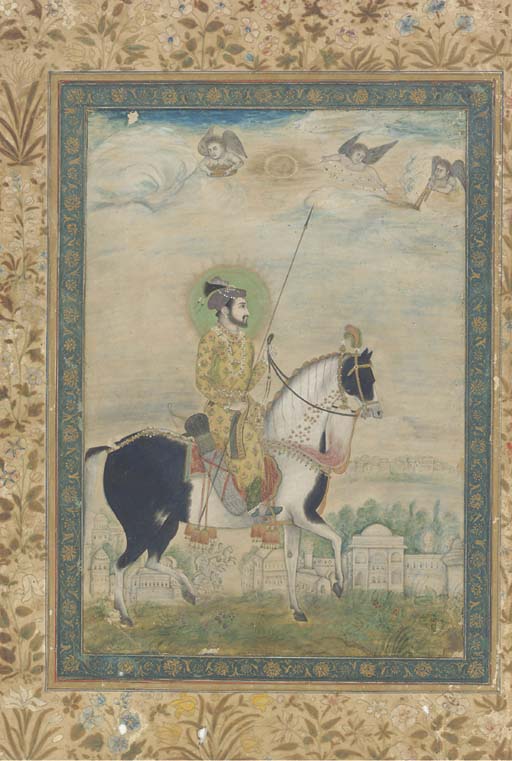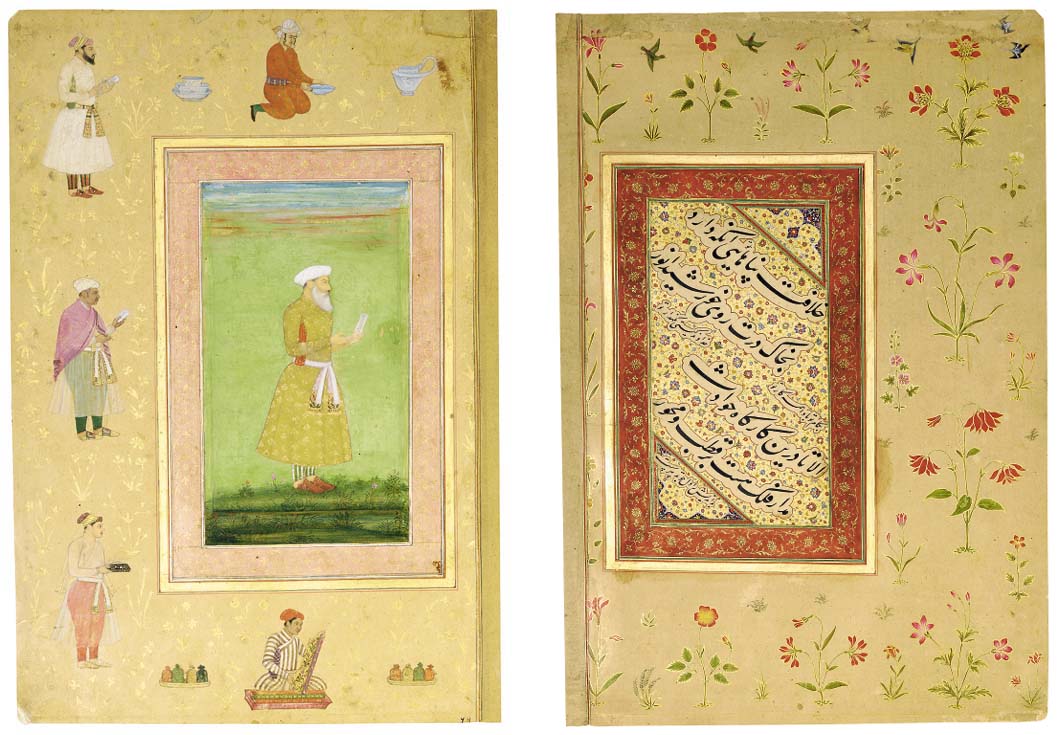

The youthful Shah Jahan out riding, as cherubs look on
Source: http://www.christies.com/LotFinder/search/LotDetail.asp?sid=&intObjectID=4457062&SE=CMWCAT03+291699+%2D712105245+&QR=M+1+86+Aqc0000900+282873++Aqc0000900+&entry=india&SU=1&RQ=True&AN=87
(downloaded Feb. 2005)
"A Double-sided Miniature: Shah Jahan on a Horse. India, Mughal, 17th Century. Gouache and gold on paper; depicting the nimbated Shah Jahan riding with lance raised, with angels above and a city in the distance, with gold and blue borders bearing gold scrollwork; the reverse with a nimbated young prince seated on a rocky outcrop holding a falcon and facing his attendant, surrounded by a gold border with nastaliq calligraphy in cartouches and salmon colored border with gold scrollwork; mounted on an album page decorated with flowers on both sides, the reverse bearing a circular stamp with nastaliq inscriptions at upper left corner of album page. Folio: 15 1/8 x 10 3/8 in. (38.4 x 26.4 cm.); image: 10 7/16 x 7 5/16 in. (26.5 x 18.5 cm.)."

A leaf from the "Late Shah Jahan" Album, probably looted by Nadir Shah in 1739
Source: http://www.christies.com/LotFinder/search/LotDetail.asp?intObjectID=2729820&SE=CMWCAT02+44450+%2D1485617171+&QR=M+1+6+Aqc0000900+43972++Aqc0000900+&entry=islamic&RQ=False&AN=7
(downloaded Sept. 2001)
"Mughal School circa 1650 and Safavid School, circa 1530. A leaf from the "Late Shah Jahan" Album. Gouache heightened with gold on paper, recto with the bearded figure of 'Ala al-Mulk Tuni holding an inventory list in his hand, the margins with elaborately drawn portaits of staff recording the Imperial porcelain, jewels and bolts of cloth, verso with four lines of black nasta'liq within gold clouds highlighted with polychrome flowers, the margins with finely drawn floral decoration outlined with gold with tiny figures of birds, slight water staining, generally good condition. Folio 15 1/8 x 10¼ in. (38.4 x 26.4 cm.); miniature 7¾ x 4½in. (19.7 x 11.5 cm.); calligraphy 6 7/8 x 3¾ in. (17.5 x 9.6 cm.).
Lot Notes: This portrait is from the so-called Late Shah Jahan Album which was dispersed in Paris about 1909. Traditionally it is thought to have been part of the loot from Delhi taken in 1739 by Nader Shah. In the late 19th century it was taken to Russia by a brother of Nasr al-Din Shah, the Qajar ruler of Iran and sold to a dealer who brought it to Paris. This leaf is typical of the album which concentrated on portraits of the elderly emperor and his nobles. The borders often show, as here, men associated with the central personage.
'Ala al-Mulk Tuni was a Persian from the city of Tun in the province of Kuhistan. He came to India in 1633-34 and died in 1663 at the age of nearly seventy. In 1641 he entered the service of Shah Jahan in the ministry of finance, later becoming Khan-i-Saman, a title encompassing Lord High Steward and Lord Chamberlain, and controlled the whole expediture of the royal household. In 1649 he was given the title of Fazil Khan and continued to serve under Aurangzeb. A man of blameless character and sound judgement, he was known for his proficiency in astronomy, mathematics and physical science. Under his directions a large part of the irrigation canal of the city of Lahore was remade. (Hollis H.: "Portrait of a nobleman", in Bulletin of the Cleveland Museum of Art, vol. 33, no. 7, 1946, pp. 180-81, 185).
Other portraits of 'Ala al-Mulk Tuni are known; by Chitarman (Martin, F. R.: The Miniature Paintings and Painters of Persia, India and Turkey, London, 1912, pl.187A; Beach, M. C.: The Grand Mogul. Imperial Painting in India, 1600-1660, Williamstown, Massachusetts, 1978, p.112) and by Jalal Quli (Leach, L.: Mughal and Other Indian Paintings from the Chester Beatty Library, London, 1995, p. 431, no.3.47). He also appears in durbar images from the Padshanama (Beach, M. C. and Koch, E.: King of the World. The Padshahnama, an Imperial Mughal Manuscript from the Royal Library, Windsor Castle, London, 1997, pl.19, centre right and pl.32, centre right with a scroll).
The calligraphy on the reverse has been attributed to Mir 'Ali (Ehnbom D. J., Indian Miniatures. The Ehrenfeld Collection, New York, 1985). Mir 'Ali Haravi (d.1556) is one of the most influential of all the practitioners in this highly respected art. With Sultan 'Ali Mashhadi he is credited with having invented nasta'liq script (Schimmel, Annemarie: Calligraphy and Islamic Culture, New York and London, 1984, p.36). The works of leading Persian calligraphers were particularly prized at the Mughal court."
== Indian Routes index == Indian Routes sitemap == Glossary == FWP's main page ==